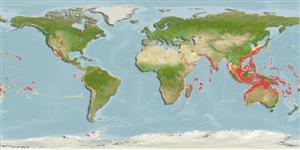Common names from other countries
分類 / Names
俗名 | 同種異名 | Catalog of Fishes(屬, 種) | ITIS | CoL | WoRMS | Cloffa
Elasmobranchii
板鰓亞綱 (鯊魚與魟魚) (sharks and rays) >
Myliobatiformes (Stingrays)
鰩目 (Stingrays) >
Dasyatidae (Stingrays)
土魟科 (Stingrays) > Dasyatinae
Etymology: Taeniurops: From feminine Latin noun, 'taenia' = ribbon or band, ancient Greek 'oura' = tail, referring to fin fold underneath tail and Greek 'ops' = appearance; originally proposed as a subgenus of Taeniura (Richard Bajol, pers. Comm. 06/16)..; meyeni: Named for Franz Julius Ferdinand Meyen (1804-1840), physician and botanist (R. Bajol, pers.comm. 06/16)..
More on authors: Müller & Henle.
Issue
same spelling in 3263
Environment: milieu / climate zone / depth range / distribution range
生態學
海洋 礁區魚類; 深度上下限 1 - 500 m (Ref. 37816), usually 20 - 60 m (Ref. 30573). 熱帶; 41°N - 36°S, 25°E - 77°W
Indo-West Pacific: Persian Gulf (Ref. 68964), Red Sea and East Africa to southern Japan, Micronesia, tropical Australia and Lord Howe Island. Eastern Pacific: known only from oceanic islands (Cocos and the Galapagos) but because of sheer number, individuals may colonize the Central America mainland (Ref. 28023). More widely known as Taeniura melanospila Bleeker 1853, a junior synonym based on the description of a juvenile specimen.
印度-西太平洋: 紅海而且東非到日本南部,密克羅尼西亞,熱帶澳洲與羅得豪島。 東太平洋: 已知只來自大洋性島嶼 (可可島與加拉巴哥島)了但是由於絕對的數字, 個體可能移殖至中美洲大陸.(參考文獻 28023) 更廣泛地被稱為以幼年標本的描述為依據的 Taeniura melanospila Bleeker 1853 ,一個次同種異名。
Length at first maturity / 大小 / 重量 / 年齡
Maturity: Lm 105.0, range 100 - 110 cm
Max length : 330 cm TL 雄魚/尚未辨別雌雄; (Ref. 30573); 最大體重: 150.0 kg (Ref. 11228)
A large stingray with a circular disc, no thorns, a black and white mottled upper surface, and a deep and prominent ventral skin fold that extends to the tail tip (Ref. 6871).
一個大的魟具有一個圓形的體盤 , 沒有刺,一個黑白的有斑點的上表皮 , 與延伸到尾部頂端的深的而且突出的腹皮膚摺層。 (參考文獻 6871)
Occurs in a wide range of habitats, from shallow lagoons to outer reef slopes (Ref. 1602). Feeds on bottom fish, bivalves, crabs and shrimp (Ref. 5578). Ovoviviparous (Ref. 50449). Smallest free-swimming specimen recorded was 33 cm WD. Caught commonly by demersal tangle net fisheries, and occasionally by longline and bottom trawl fisheries. Utilized for its meat and cartilage (Ref.58048). Found singly or in aggregates and usually with jacks and cobia swimming near them (Ref. 12951). Not normally aggressive, but it has been responsible for at least one human fatality. Sought by surf and ski boat anglers in southern Africa, but usually released unharmed (Ref. 5578). Longevity record for a specimen in an aquarium is 81 days (Ref. 12951). May reach disc width in excess of 3 m (Ref. 28023).
從潟湖淺灘到外礁斜坡,出現於寬範圍的棲息地。 (參考文獻 1602) 吃底部魚,二枚貝,螃蟹與蝦。 (參考文獻 5578) 卵胎生的.(參考文獻 50449) 各別地發現或者在聚集中而且通常有遊近他們的鰺科魚類與軍曹魚.(參考文獻 12951) 通常不具侵略性, 但是它有是至少的原因一個人類的傷亡。 被在非洲南部中的海浪與滑雪板船垂釣者追尋了, 但是通常排出沒有受傷的.(參考文獻 5578) 給在一個水族館的一件標本的壽命記錄是 81 天。 (參考文獻 12951) 可以達到被超過 3 公尺的體盤寬度。 (參考文獻 28023)
Life cycle and mating behavior
Maturities | 繁殖 | Spawnings | Egg(s) | Fecundities | 仔魚
Exhibit ovoviparity (aplacental viviparity), with embryos feeding initially on yolk, then receiving additional nourishment from the mother by indirect absorption of uterine fluid enriched with mucus, fat or protein through specialised structures (Ref. 50449). Distinct pairing with embrace (Ref. 205). With up to 7 in a litter (Ref. 6871, 12951).印度-西太平洋: 紅海而且東非到日本南部,密克羅尼西亞,熱帶澳洲與羅得豪島。 東太平洋: 已知只來自大洋性島嶼 (可可島與加拉巴哥島)了但是由於絕對的數字, 個體可能移殖至中美洲大陸.(參考文獻 28023) 更廣泛地被稱為以幼年標本的描述為依據的 Taeniura melanospila Bleeker 1853 ,一個次同種異名。
Last, P.R. and J.D. Stevens, 1994. Sharks and rays of Australia. CSIRO, Australia. 513 p. (Ref. 6871)
CITES (Ref. 128078)
Not Evaluated
人類使用
漁業: 商業性; 游釣魚種: 是的
工具
特別的報告
下載 XML
網路資源
Estimates based on models
Preferred temperature (Ref.
115969): 23.3 - 29.1, mean 28 (based on 1102 cells).
Phylogenetic diversity index (Ref.
82804): PD
50 = 1.0000 [Uniqueness, from 0.5 = low to 2.0 = high].
Bayesian length-weight: a=0.00646 (0.00265 - 0.01571), b=3.06 (2.86 - 3.26), in cm Total Length, based on LWR estimates for this (Sub)family-body shape (Ref.
93245).
營養階層 (Ref.
69278): 4.2 ±0.69 se; based on food items.
回復力 (Ref.
120179): 非常低的, 最小族群倍增時間超過14 年 (Fec=7).
Fishing Vulnerability (Ref.
59153): Very high vulnerability (90 of 100).
